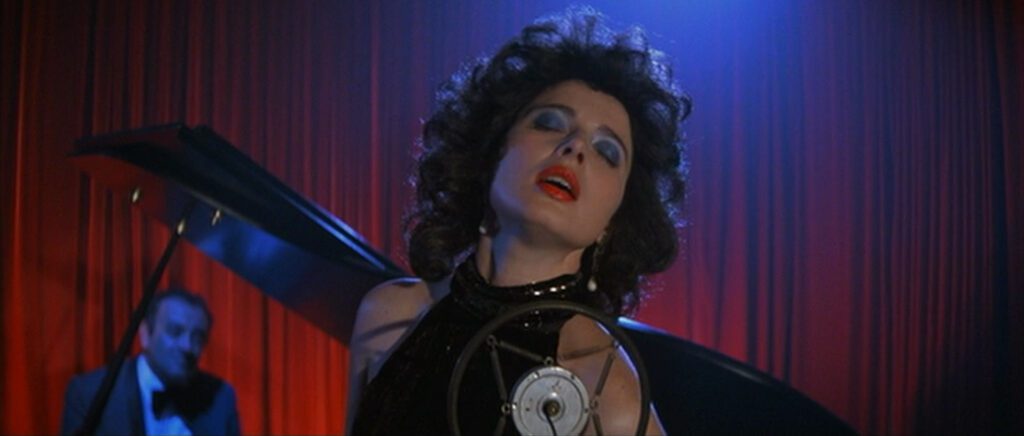
Blue Velvet
1986, directed by David Lynch
At the beginning of Blue Velvet, Jeffrey Beaumont’s father has a stroke while watering his lawn. The incident shows every sign of being a MacGuffin. It brings Jeffrey back home from college; it leads him to discover the severed ear on his way home from the hospital; and thenceforth it barely makes a ripple in the plot. Even as a MacGuffin though it seems unnecessary. No elaborate excuse is needed to put Jeffrey in Lumberton, nor for him to stumble across the ear. His father’s incapacity plays a more important role – it makes Jeffrey the man of the household for a few days, giving him a taste of adulthood.
In many cultures, and during much of history, Jeffrey would have been squarely within the bounds of manhood already, but the college years of a middle class American male can be a time of transition. In any case Blue Velvet traces Jeffrey’s entry into mature adulthood, and the story is about his choice between two paths. He can remain in the world he was raised in, or he can enter a “dark” underworld populated by people like Frank and Dorothy. He’s torn between the two, falling in love with Sandy but tempted by the mystery, sex, and excitement of the cruel and dangerous world that Dorothy inhabits.
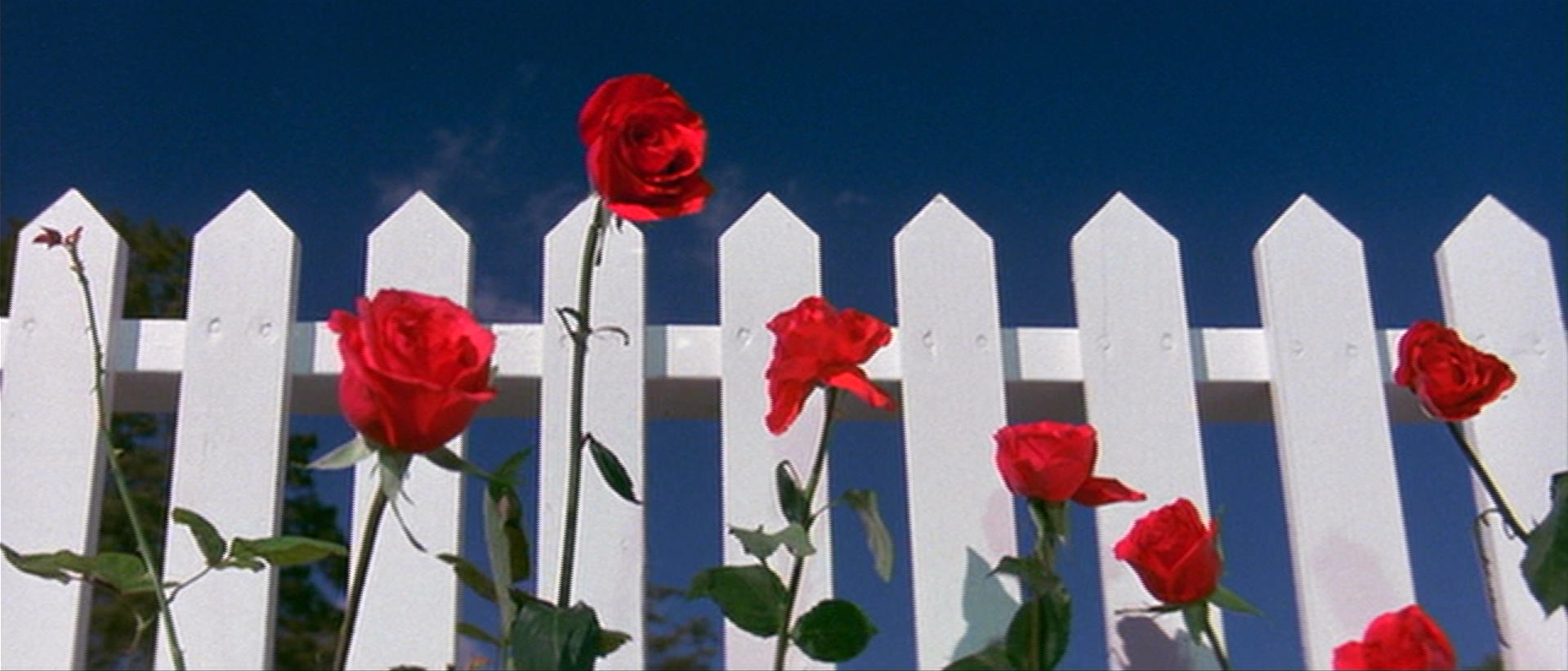
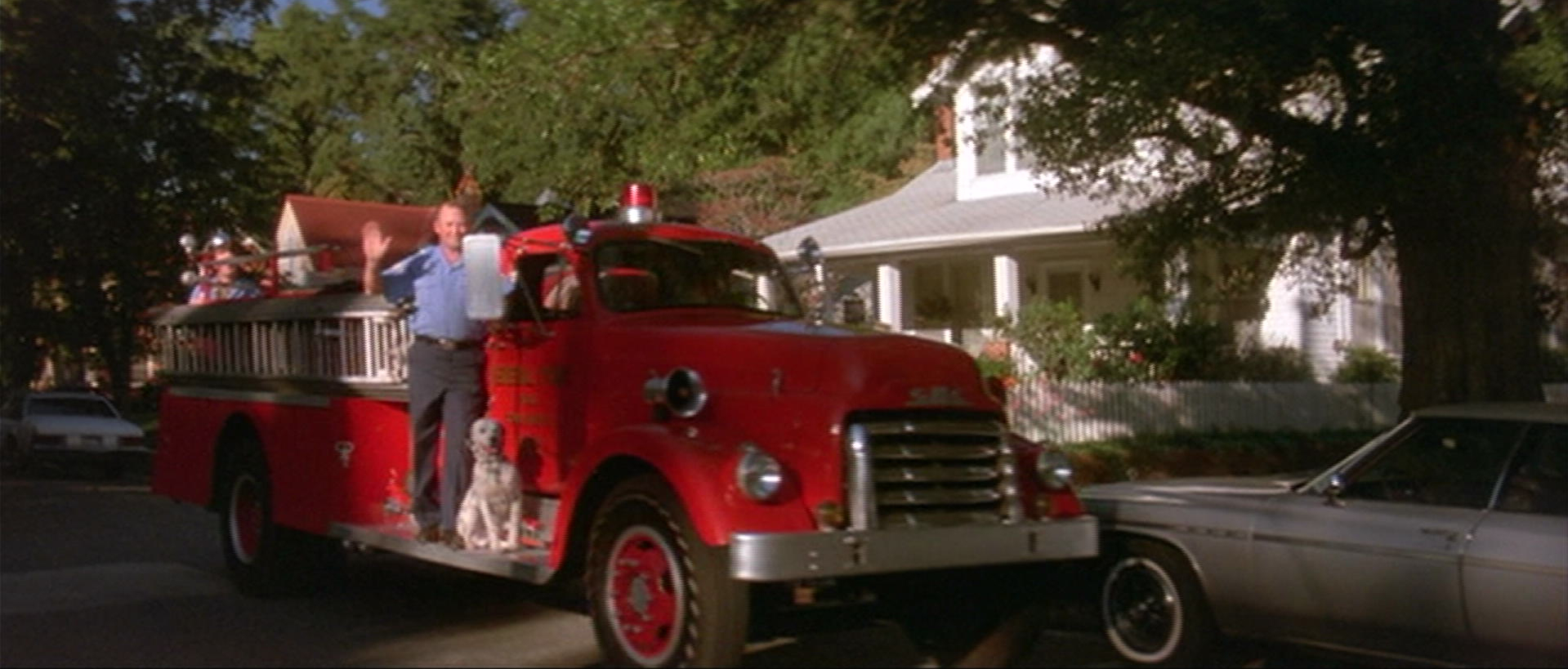
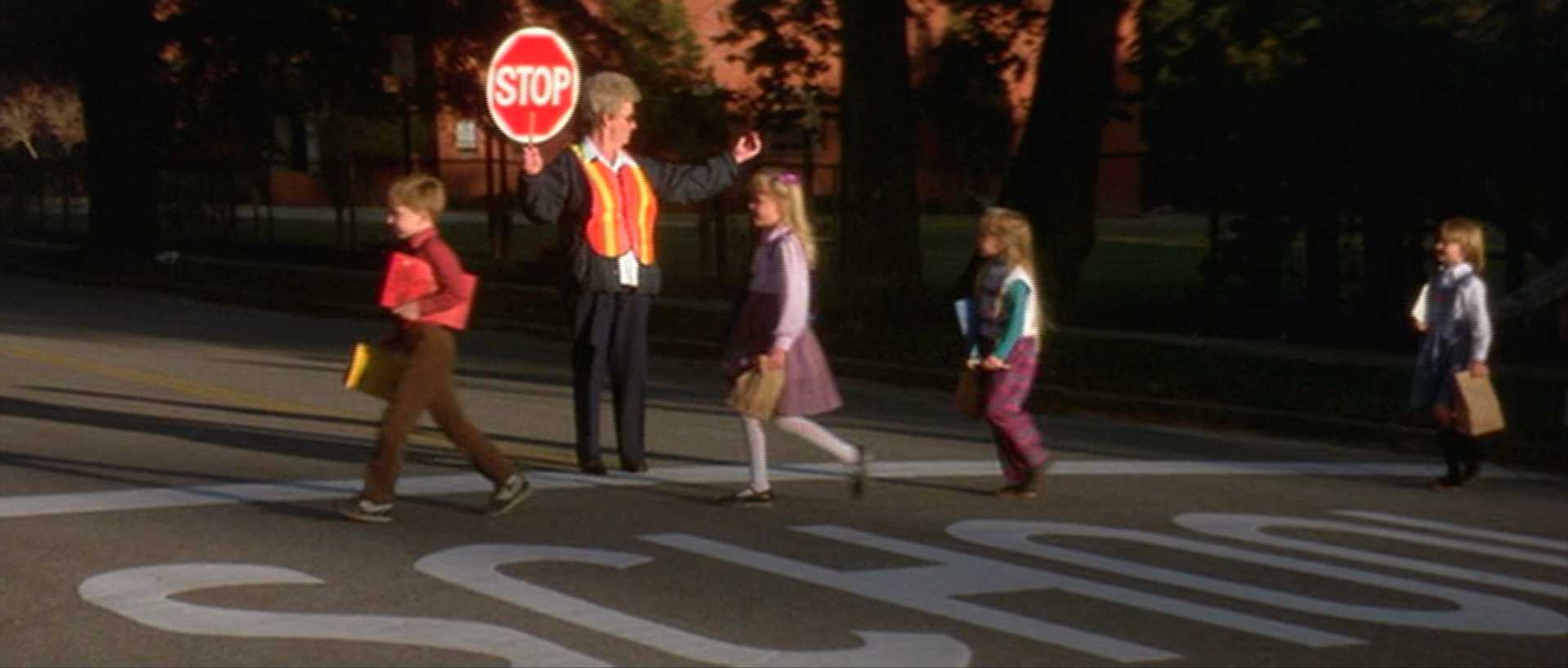
However the choice is not as simple as all that. The opening shots give us a stereotypical picture of mid-century American life – blue sky, a picket fence, tidy houses with manicured yards, an average-looking white family watching television. But if we look closer it’s not a social milieu or a lifestyle that these shots are defining. The primary colors and the simplicity of life are too exaggerated. A bright red fire truck passes dreamily down a street, a fireman waving to the camera with a dalmatian beside him. A crossing guard shepherds schoolchildren along a crosswalk. It’s not so much about middle class America, but rather a child’s view of the world. When the montage recurs near the end, it doesn’t exactly bracket the movie – rather it introduces Dorothy’s boy Donny, now rescued and playing in a park while his mother watches from a bench.
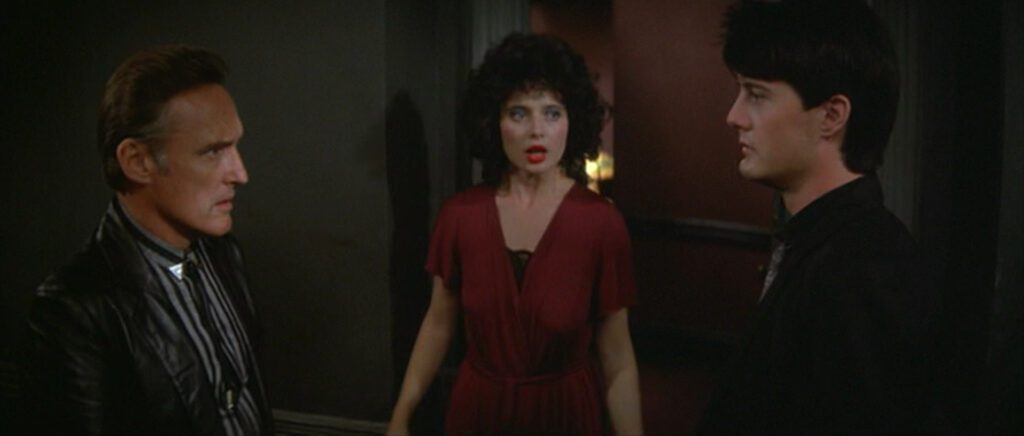
Here is the subversive point of Blue Velvet. If this is the world Jeffrey chooses – if he chooses to remain in an idealized candy-colored world of childhood – he will become like Frank, because that’s exactly what Frank has done. Frank is introduced in Dorothy’s apartment, raping Dorothy as Jeffrey watches from the closet. Everything about Frank’s behavior defines him in one word – he’s infantile. He calls Dorothy “Mommy” and says “Baby wants to fuck!” The selfishness and lack of inhibition that are so normal and so often endearing in children can become psychopathic in adults, and the physical bond between child and parent becomes perverse if it’s translated into adult sexuality. Frank is a model of what can happen when a man fails to grow up.
The image of blue velvet, so dear to Frank who loves to hold onto a piece of the cloth, represents the memory of childhood. The song links blue velvet to a woman who’s gone – ostensibly a lover, but the lyrics speak of a memory kept “precious and warm… through the years” – words that fit better onto a boyhood memory of a mother, and when Dorothy sings that line halfway through the film we see Frank watching her in the nightclub.
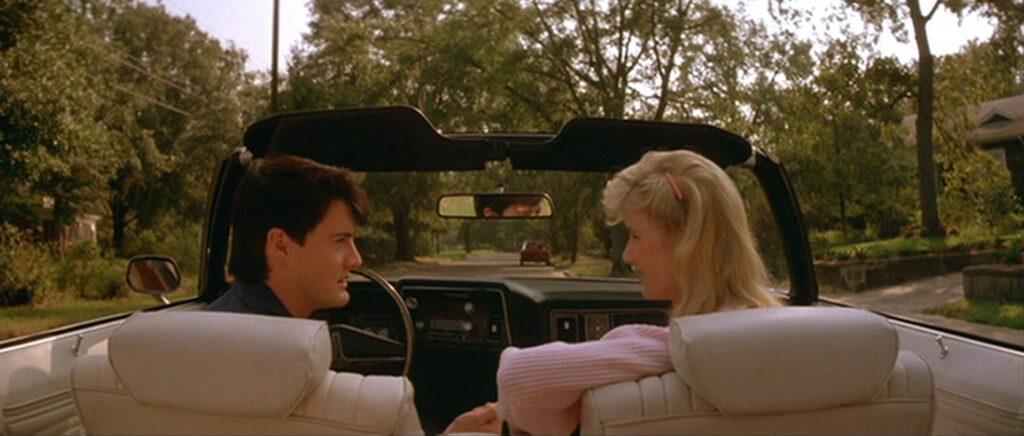
Alfred Hitchcock spent most of his career making movies about characters who carry childhood incest into adulthood, ranging in subtlety from Vertigo to Psycho, and Blue Velvet is even less subtle than Psycho. Still, unless audiences are willing to drop their romantic or idealized notions of childhood, they won’t see Frank for the overgrown child that he is. Shortly before the climax of their violent “joyride” Frank turns to Jeffrey in the back seat and recognizes a common ground: “You’re like me!” The point is not that Jeffrey would become exactly like Frank… even if he’s already moved beyond Oedipal sexuality, even if he doesn’t share Frank’s sadistic urges, he’s still headed down a dangerous path if he doesn’t give up his fantasy of continuing his childhood.
Jeffrey’s original error is not merely a matter of breaking the law by trespassing in Dorothy’s apartment. It’s his desire to look for trouble, like a petulant child bored with his ordinary life. Dorothy’s building, the Deep River Apartments, is full of warning signs. First, Aunt Barbara hopes Jeffrey’s not going by Lincoln Street, which is exactly where the building is. The elevator’s broken, as if telling him one last time to keep out, and as he proceeds a strange series of architectural discrepancies characterizes the dark world he’s entering. First of all, we can see that the building has only six floors, but Dorothy lives on the seventh, in apartment 710. The windows to the right of the closet and in the kitchen both face in the direction of a branching corridor that should make a view to the outside impossible. The apartment is unusually deep for a building that size, with a long hallway to the bathroom that’s perpendicular to the outer corridor, and although the front door is slightly recessed it still seems unlikely that there’d be space for Dorothy’s closet – it would have to protrude into the outer corridor.
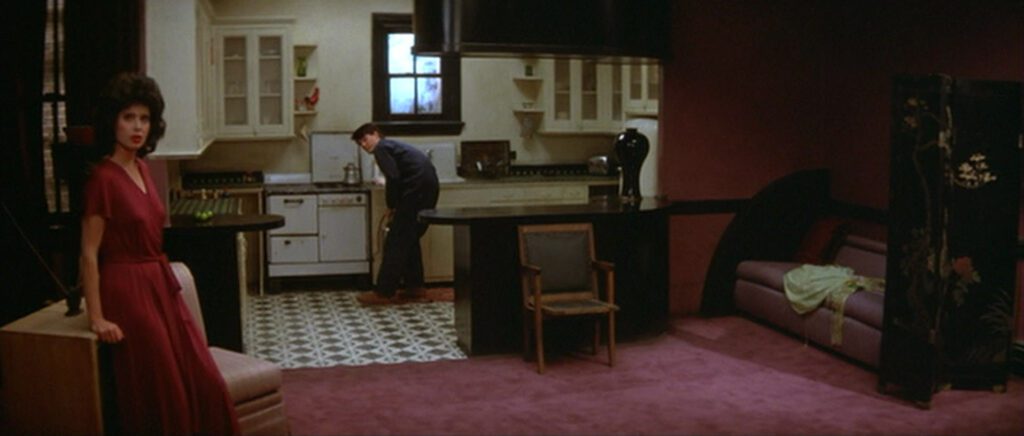
Many movies contain errors like these, usually from carelessness, but Lynch is not a careless director. It would have been easy to say that Dorothy’s apartment was on the sixth floor, but the error looks deliberate, as if Jeffrey’s entering a fantasy world that follows a different logic. Lynch does the same thing in Lost Highway when Mister Eddy takes Pete for a spin and impresses the boy by taking revenge on an aggressive motorist. Just when things turn dramatic, the Hollywood sign appears in the background to tell us that Pete is living the fantasy of a gangster movie. In Blue Velvet the architectural errors do not call the story itself into question – it’s all real within the movie’s fiction – but it does question Jeffrey’s motive for trespassing. He’s playing out his own dark fantasy, and the movie tells us that his wish to recapture his childhood is not realistic.
In Lynch’s movies dangerous fantasies are often linked to Hollywood, which stands for the broader world of entertainment media that shapes so many of society’s desires and aspirations. Blue Velvet doesn’t dwell on media’s role in shaping our fantasies, but it does recognize it. Twice we catch brief clips of action on the Beaumonts’ television. The first, a close-up of a gun advancing through a room, immediately precedes Mr. Beaumont’s stroke, which opens up a figurative “dark side” in the family’s idyllic world as the camera dives into a shadowy world of bugs under the pretty garden. The second television clip shows footsteps climbing stealthily up a stairway, and it precedes Jeffrey’s outing where he’s introduced to the Deep River Apartments. In both cases it’s as if the family’s being punished for its fascination with the dark side of life – but it’s modern mass media that feeds that fascination. Moments before his death near the end, Frank shoots Dorothy’s television set, taking symbolic revenge on an object that plays a large part in keeping society juvenile.
In contrast to Frank, Jeffrey encounters a positive model in Sandy’s father, Detective Williams, who warns him against pursuing his own investigation. Williams says he was like Jeffrey at that age, and he understands the urge to look for trouble, but he also recognizes the “horrible” side of his work. Blue Velvet acknowledges the horror of the underworld that Jeffrey explores so enthusiastically, but the movie’s stance is not moralistic. If we see Frank for who he is, it’s pointless to call him “evil”. Jeffrey asks Sandy, “Why are there people like Frank?” and the movie answers him. Frank’s dark urges are in all of us, and they always will be, but they only become a serious problem in people who fail to grow up.
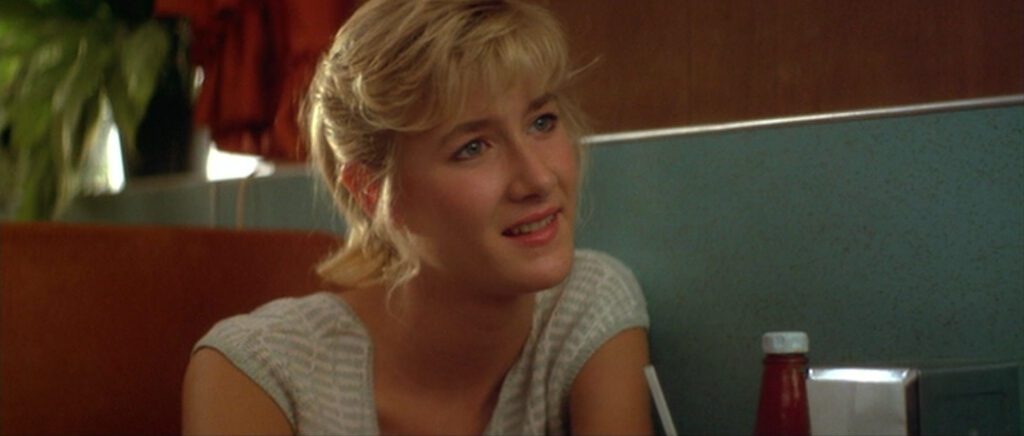
After Jeffrey and Sandy declare their love at the house party, his choice is made. He no longer pursues Dorothy nor shows any unhealthy desire for dramatic action. He only goes back to Dorothy’s apartment out of a sense of duty, and he kills Frank because he has no choice. Dorothy and her son are saved, Mr. Beaumont is well again, and although much damage is done, a sense of order prevails. Symbolizing this order, and fulfilling the promise of Sandy’s dream, a robin appears on the Beaumonts’ windowsill with a bug in its beak. The robin and the beetle represent the “light” and “dark” sides of our world that have fought for Jeffrey’s soul, but it’s ironic to see the light side preying on the dark side. The difference, again, is not a matter of morality but of the natural order of things.
CONNECTIONS:
The Wizard of Oz – Character named Dorothy with red shoes who’s trapped in a fantasy world
Shadow of a Doubt – Youth on cusp of adulthood tempted by excitement from a “dark side” linked with incest; contest between ordinary America and an underworld of crime
Vertigo – Portrait of a man clinging to the attachments of his childhood
Psycho – Villain is a dangerously infantile man sexually possessive of his mother
The Cook the Thief His Wife and Her Lover – Study of a vulgar man-child (psychological focus in the Lynch film, socio-political in the Greenaway)
The Straight Story – Ominous opening in a stereotypical American yard, with either a stroke or a foreshadowing of one